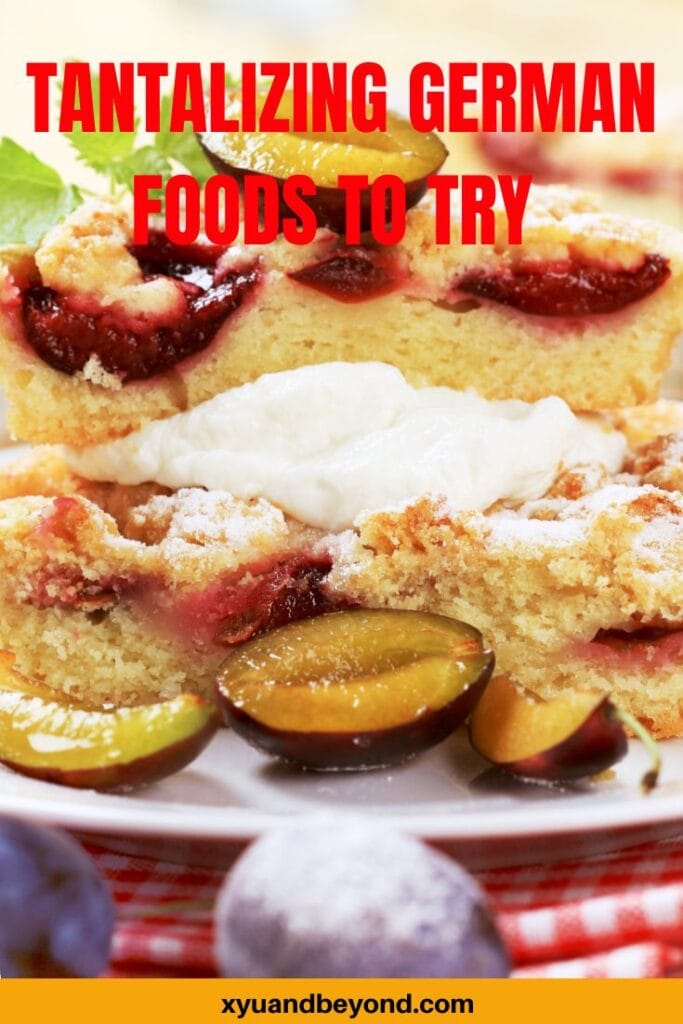34 Best German Foods to Try | Traditional German Food
All tourists spend a share of their travel budget on food. If you want to take a deep dive into the culture of a city, and really experience the heart of a new place you must try the local food. I would also suggest finding a local market to check out what the locals buy and eat.
Traditional German food tends toward rustic and very hearty meats like pork and goose feature quite a bit along with fish, peas, beans, potatoes and of course Germany’s most popular food the German sausage. The most famous foods in Germany are of course Black Forest Gateau, Currywurst Sausage and pretzels but there is much more to German cuisine than these three.
German food culture was greatly influenced by Frederick the Great. In the 18th century, King Frederick ordered his subjects to eat mainly cucumbers and potatoes. He encouraged using these items because they were cheap and fit the frugal Germanic lifestyle. They are still favourites in Berlin.

34 German foods you must try
Germany is famous for its delicious and hearty cuisine, and there are a few German dishes few German dishes you need to try when visitingGermany. First on the list is sauerbraten, a tender and juicy pot roast that is marinated in a mixture of vinegar, water, and spices before being slow-cooked to perfection. Another classic German dish is schnitzel, a breaded and fried cutlet of meat that can be made from pork, veal, or chicken. It is often served with potatoes and a side of creamy sauce.
For a vegetarian option, try käsespätzle, a type of soft egg noodle dish topped with melted cheese and caramelized onions. And of course, no German meal would be complete without a serving of bratwurst, a delicious sausage made from pork, beef, or veal, grilled to crispy perfection and served on a bun with mustard and sauerkraut. These dishes are just a taste of what Germany has to offer, and they are sure to satisfy your culinary cravings.
German Foods – Sausages
My favourite German foods and the most well-known are of course sausages. Especially popular German food includes over 1200 varieties of German sausages that can be found all over the country. Some are enjoyed street foods in Germany like Currywurst or Bratwurst, while others are spreadable like Teewurst.
When someone talks about types of German wurst they are talking about boiled sausages with either fruit, vegetables, or blood as a filling. Germany eats the most amount of sausages in the world over 27% of all sausages made. The second-largest consumer is Poland.
Currywurst
You need to try Currywurst when in Germany. It is made of boiled and then fried pork sausages. After cutting them, the pieces are seasoned with curry powder and ketchup. Currywurst is served with french fries and German beer, which is very popular. During the Oktoberfest in 2019, over 2 million gallons of beer were consumed.
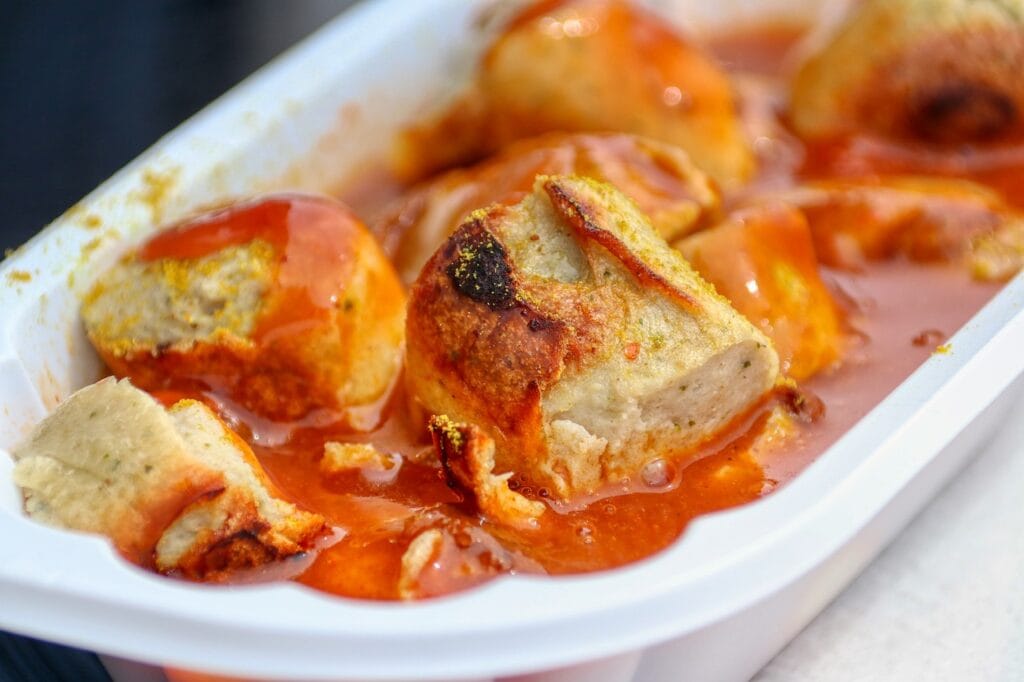
Zungenwurst
Zungenwurst is a blood sausage that typically consists of a mixture of pork blood, fat, and pieces of pickled tongues, seasoned with ground pepper and occasionally other strong spices. Usually, the blood sausage is entirely made of animal parts, containing no fillers or cereals. Since the sausage is typically cured and dried, it requires no cooking before eating.
Bregenwurst
Bregenwurst is a traditional German sausage that is made from pork, pork belly, and flavoured with and white pepper, cumin, mace, and onions.
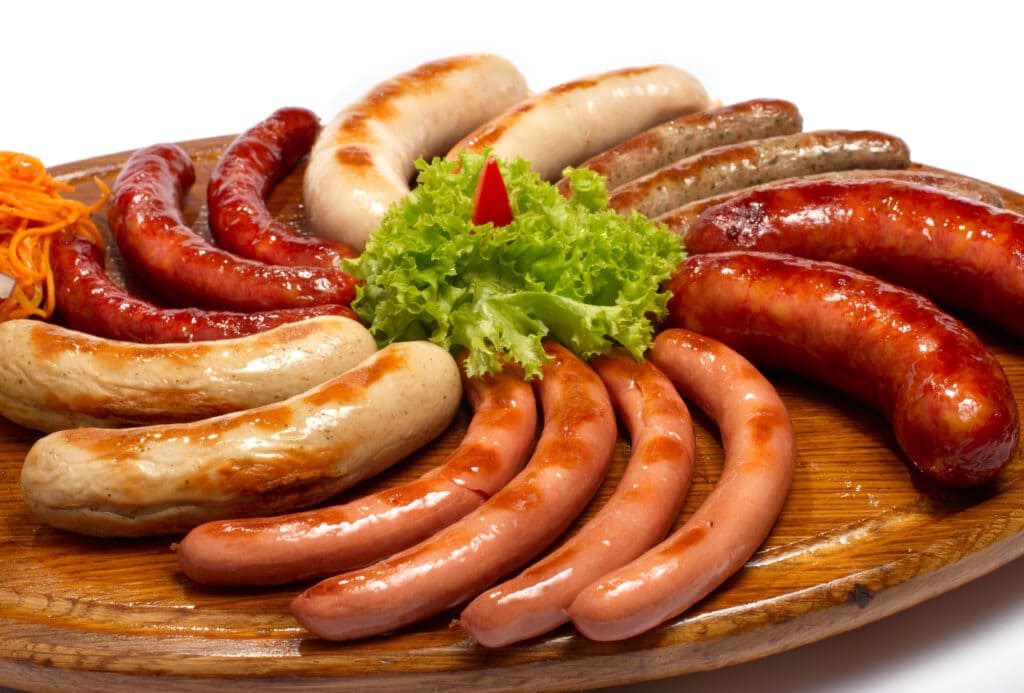
Bauerwurst
A German smoked sausage that is a coarse-textured sausage originated in Germany. It’s smoked and has a highly seasoned flavour with onion, garlic, marjoram and mustard seeds.
Beerwurst/Bierwurst
Originally from Bavaria, Beerwurst is dark red and not made with beer but it is served with beer as a snack. It has a rich heavy garlic flavour and is seasoned with black pepper, paprika and mustard seeds.
Bockwurst
A ground veal sausage that gets its flavour from chives and parsley. Most places sell it raw, and it requires special care during preparation to ensure it is cooked thoroughly.
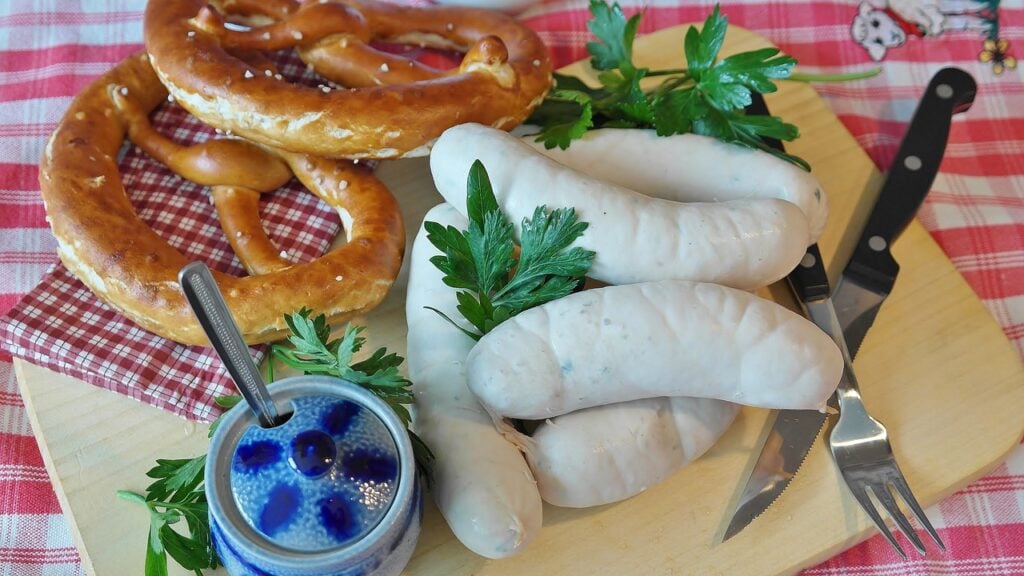
Head Cheese
Just the name of it gives me shivers and knowing that it isn’t cheese is gross lol. It’s a sausage made from the meat in the heads of pigs, calves and sometimes sheep or cows. The meat is seasoned and then mixed with a broth and poured into a mould.
The mixture is typically flavoured with ingredients such as garlic, onions, pepper, salt, nutmeg, and sugar. When cooled it is then sliced and served.
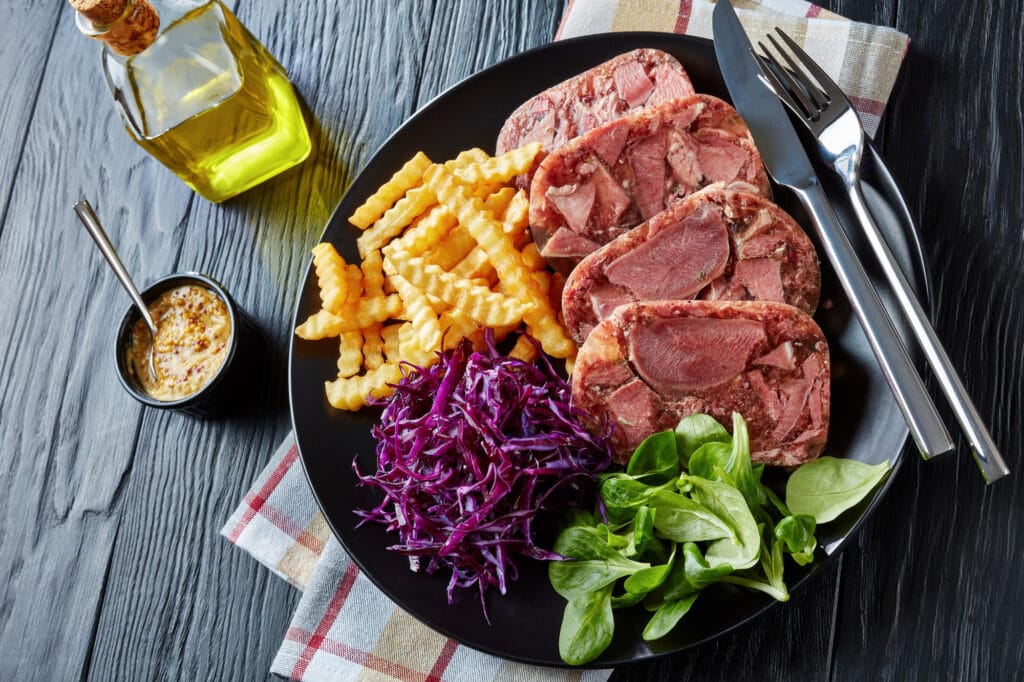
Knackwurst
Made from beef, pork or both, and sometimes veal it is flavoured with garlic. The name comes from its snap when you bite into it. Knackwurst is commonly grilled and served with sauerkraut.
Thuringer
A sausage of either pork or a combination of pork and beef. You can buy it fresh or smoked, and it is often seasoned with marjoram and caraway.
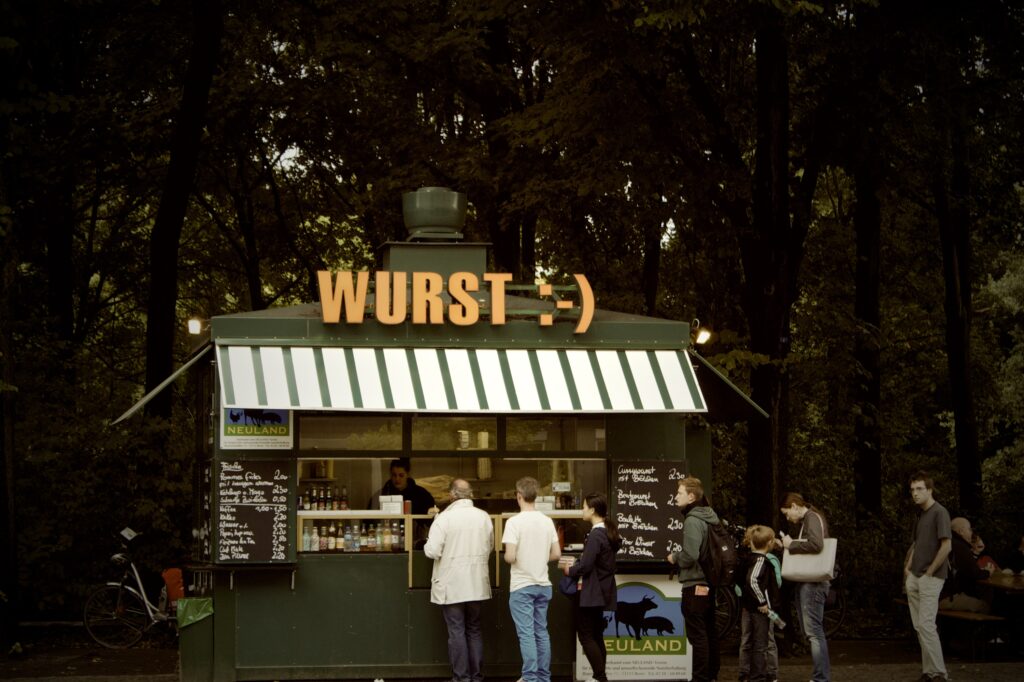
Weisswurst
Weisswurst is a traditional Bavarian sausage made from minced veal and pork back bacon. A rather funky-looking sausage as it is white but that comes from the ground veal or pork that is used. Flavourings include parsley, Ginger Onions and lemon. Serve it with beer, sweet mustard and rye bread.
Gelbwurst
Gelbwurst or yellow sausage is traditionally stuffed into natural casings dyed with saffron. The sausage itself may consist of pork, veal or beef, bacon, or chicken, and it is typically flavoured with various spices such as nutmeg, mace, pepper, ginger, cardamom, and lemon, depending on the region.
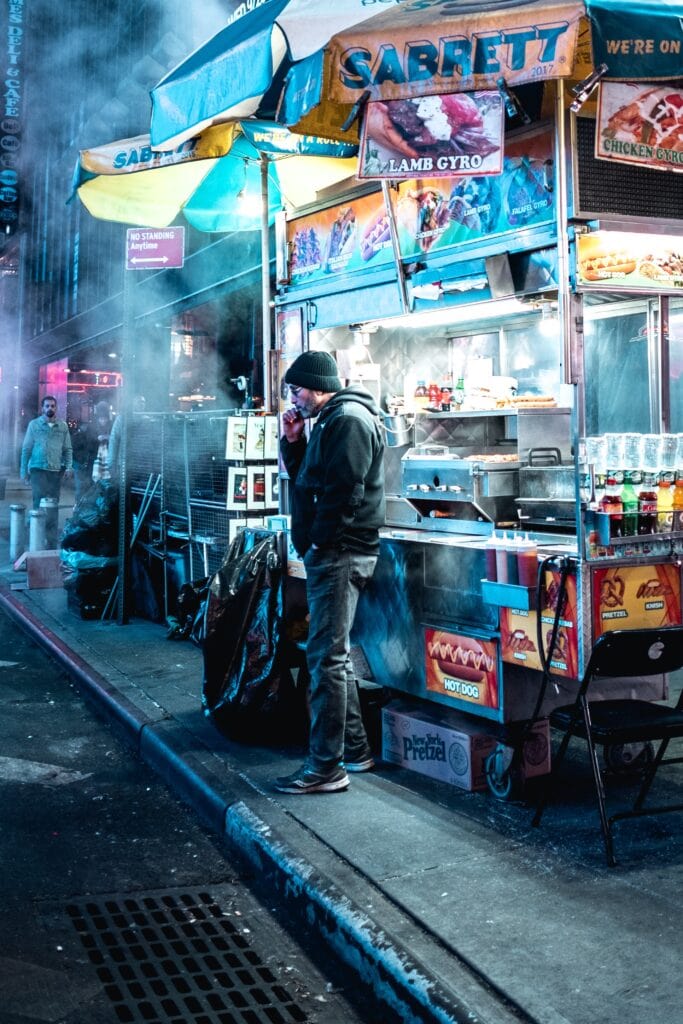
Traditional German Food
Classic German dishes are not all about sausages the food is hearty, rich and very diverse. It really is all about comfort food using locally sourced ingredients that are shaped by the agricultural traditions of the country. Then there is the influence of immigrants that brought with them their speciality dishes. German food is much more than sausages and beer.
Eisbein mit Sauerkraut
We all probably know that most popular German food Sauerkraut. One of the many favourite dishes of Germany is Eisbein a pork knuckle that has been cured and then braised for many hours so that the thick layer of fat on top turns to crackling. In Berlin, it is sold cured and served with sauerkraut. This is typical of the cuisine of Berlin
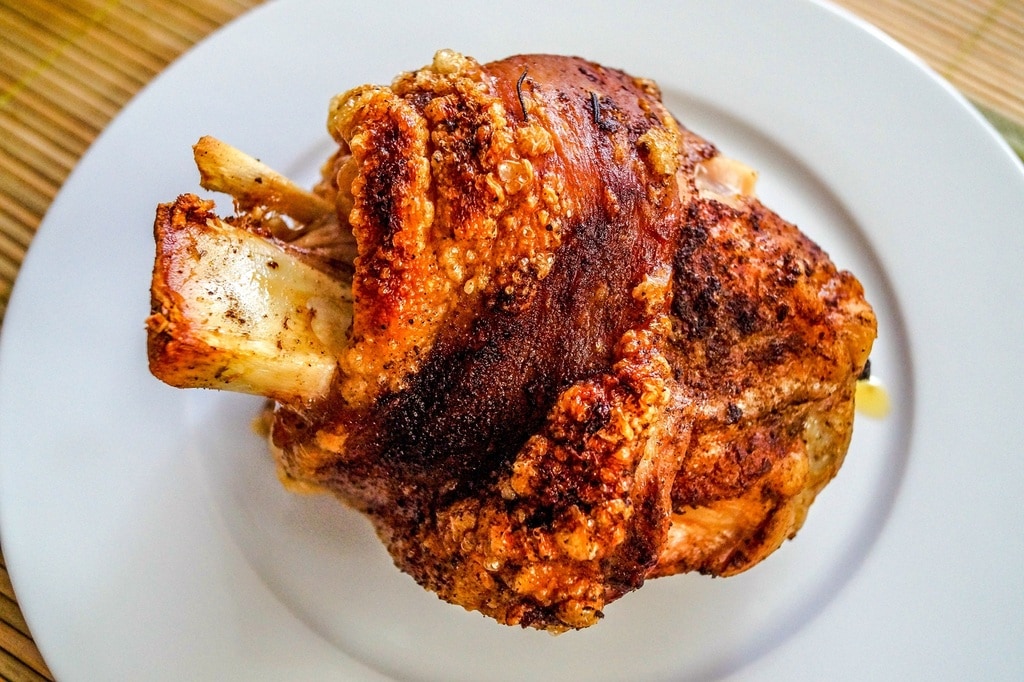
Sauerkraut
Sauerkraut is frequently served alongside sausages or schupfnudeln, a type of elongated gnocchi popular in southern Germany and Austria. Sauerkraut is essentially a salt fermented cabbage that probably originated in China centuries ago.
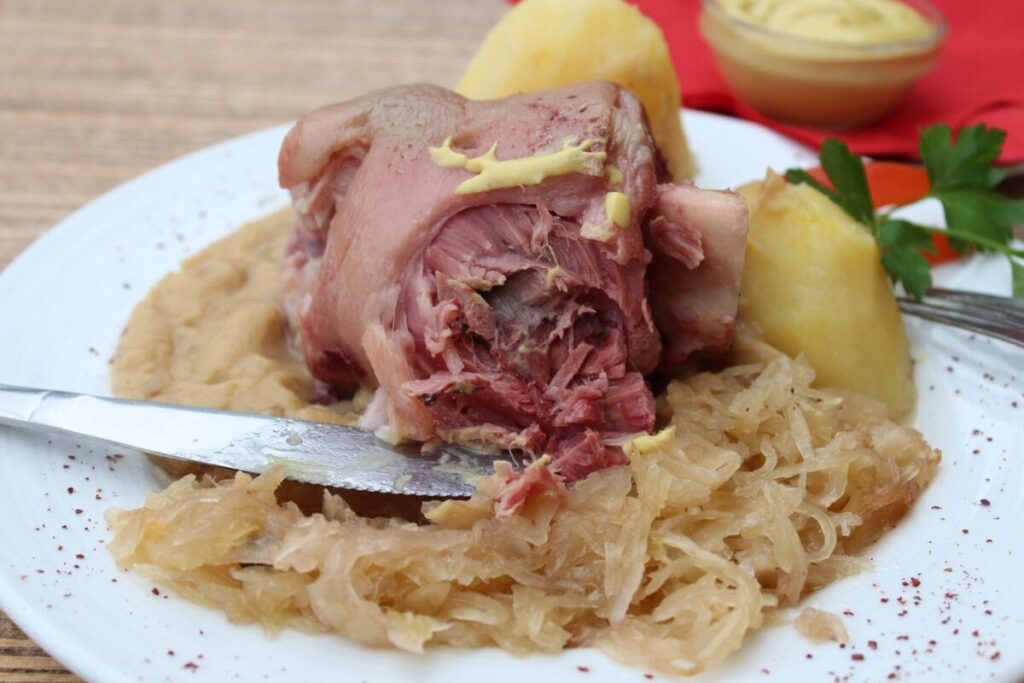
Schweinshaxe – roasted pork hocks
Traditional german dishes such as Schweinshaxe are not to be confused with Eisein, schweinshaxe is also pork Knuckle but it is marinated and then roasted at a low temperature to ensure a crisply crackly skin.
Senfeier
Senfeir is a very traditional German breakfast of boiled eggs served in a mustard sauce. Senfeier, also known as eier in senfs, is usually served after Easter to use up all the leftover Easter Eggs. It is also a popular dish among students as it’s easy and fast to prepare.
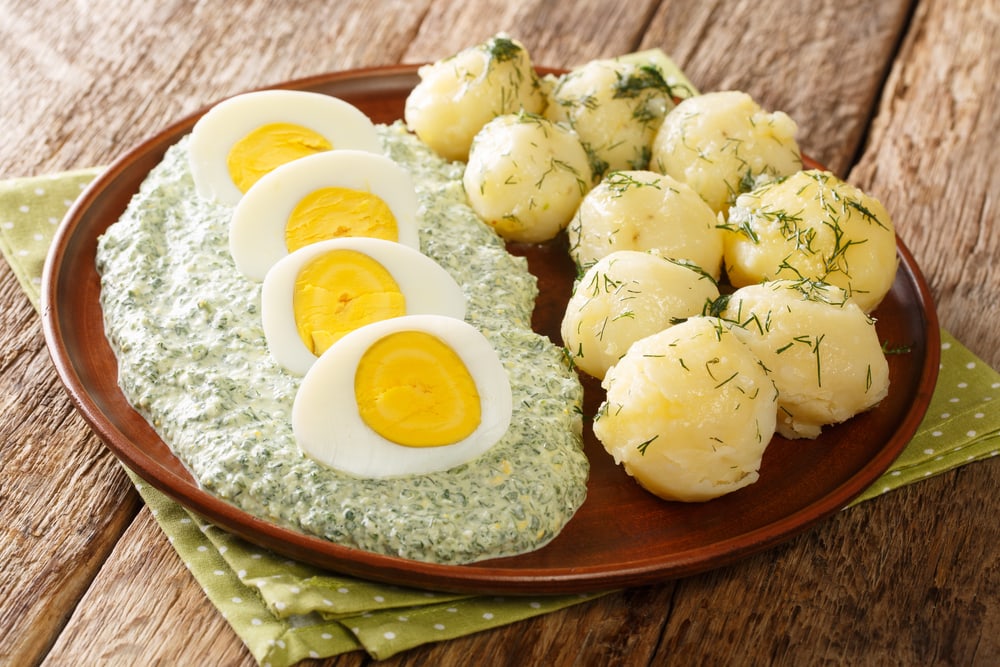
Kartoffelpuffer
A typical German side is Kartoffelpuffer which been served in Germany and other European countries since at least the 18th century. This authentic German food is also known as Reibekuchen. These cakes are a sort of hash brown or latke. They are made of finely grated potatoes, flour, eggs and onions, and in Switzerland, they are called rosti. They can be served with savoury accompaniments or sweet. In Poland for example they are served with meat stews and are delicious. Ireland has their own version made with mashed potatoes called Boxty and the Jewish version which uses coarsely grated potatoes is a Latke.
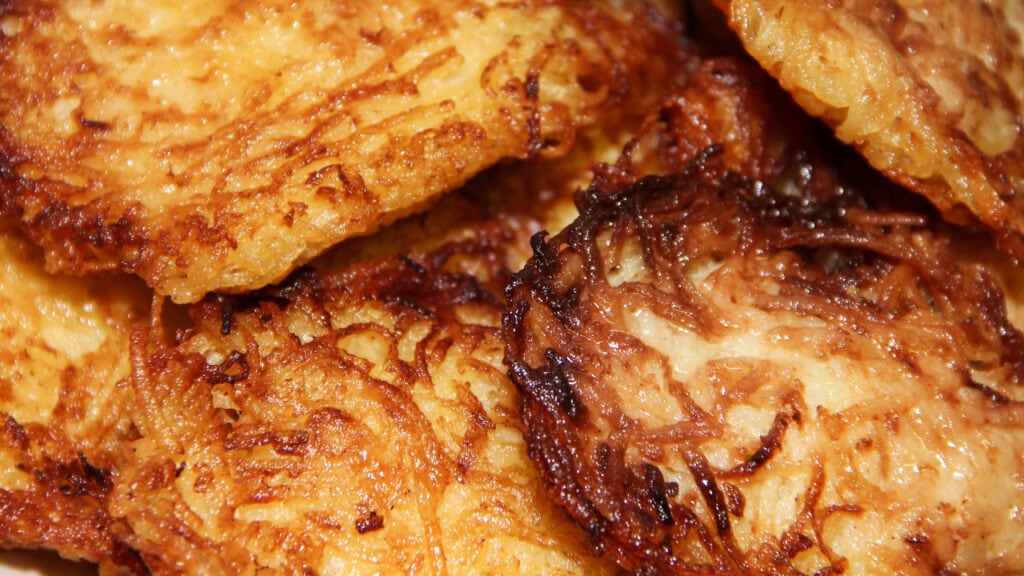
German Potato salad
Unlike North American potato salad the Southern Germany version is not mayonnaise based it is leftover cold potatoes mixed with a vinegar-based dressing complete with bacon and bacon drippings, onions herbs and a mustard dressing.
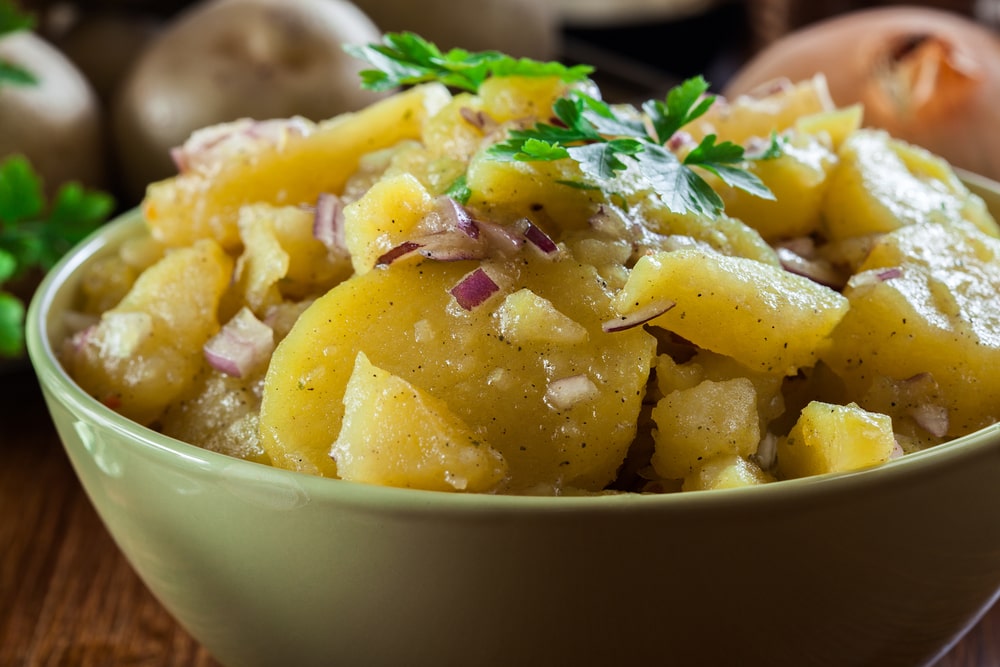
Rouladen
Rouladen is a German dish that consists of bacon, onions and pickles wrapped with very thin slices of beef which are coated in mustard and cooked until the beef is tender and served with red cabbage, gravy, and potato dumplings or mashed potatoes.
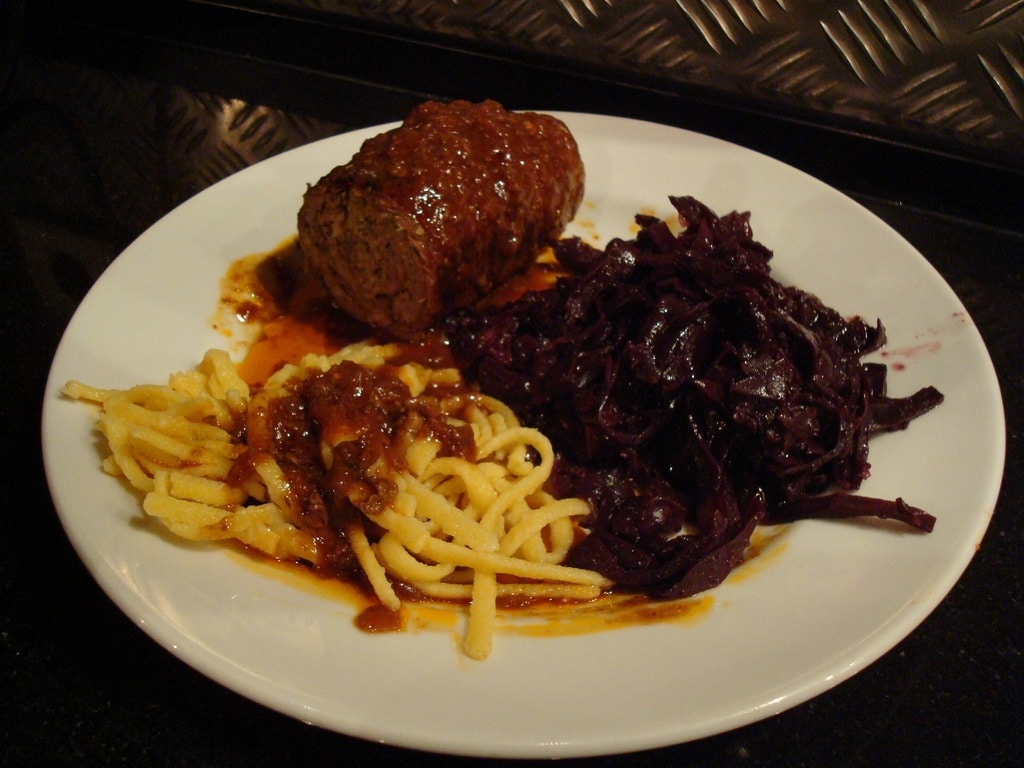
Hassenpfeffer – Rabbit Stew
Does anybody remember Laverne and Shirley and this “schlimazel! Hasenpfeffer Incorporated!”? It was the beginning of the show chanted by Penny Marshall and Cindy Williams, which marked the start of the star’s long-running ABC sitcom. This line is actually a Yiddish-American hopscotch chant. In Germany, Hasenpfeffer is actually rabbit stew.
The German rabbit dish called “hasenpfeffer” is made by marinating the rabbit in a highly spiced (not spicy) and vinegary concoction for 2 or 3 days, and then slow-cooking the rabbit in the same liquid after.
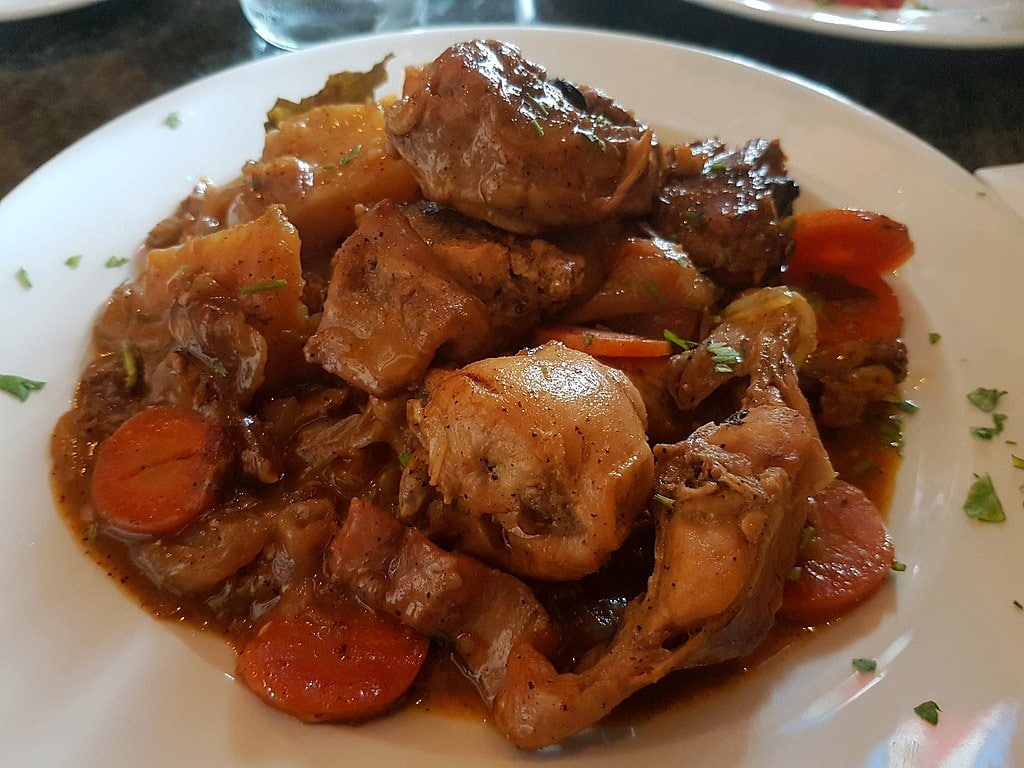
Spätzle
If you’re a vegetarian, this food is for you. Spätzle is a pasta dumpling made with fresh eggs, typically serving as a side for meat dishes with gravy.
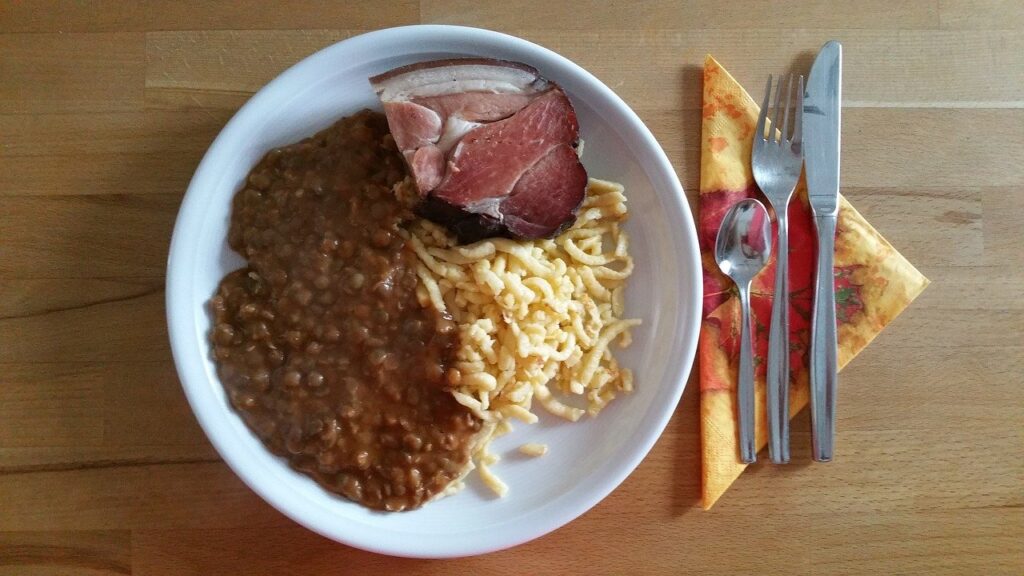
Eintopf
Eintopf is a classic German food a one-pot stew that can include a wide variety of ingredients that the cook can find in the fridge. It is a meal-in-one that will typically contain broth, vegetables, potatoes, and meat. Sometimes it may include pulses such as lentils, and it’s usually served mit Brot (with bread).
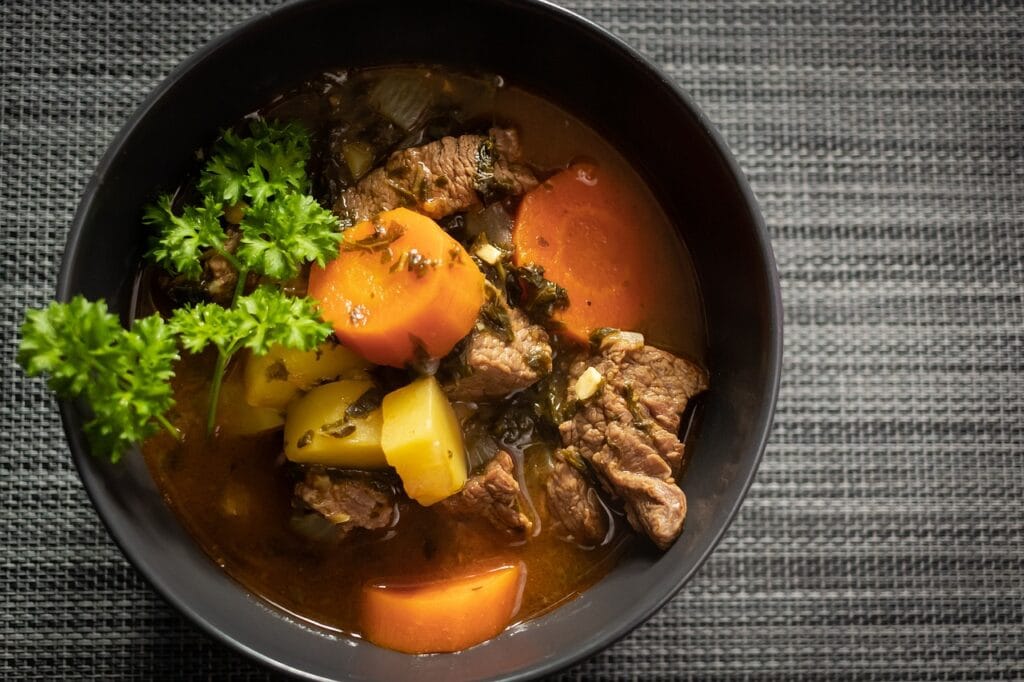
Sauerbraten
Sauerbraten is one of Germany’s National Dishes it is a German pot roast – it literally translates as ‘sour roast’. The sour part refers to the pickling of the meat in a sweet and sour gravy-like sauce, which is then slowly roasted in a dish. The dish is usually served with Kartoffelknodel or potato dumplings.
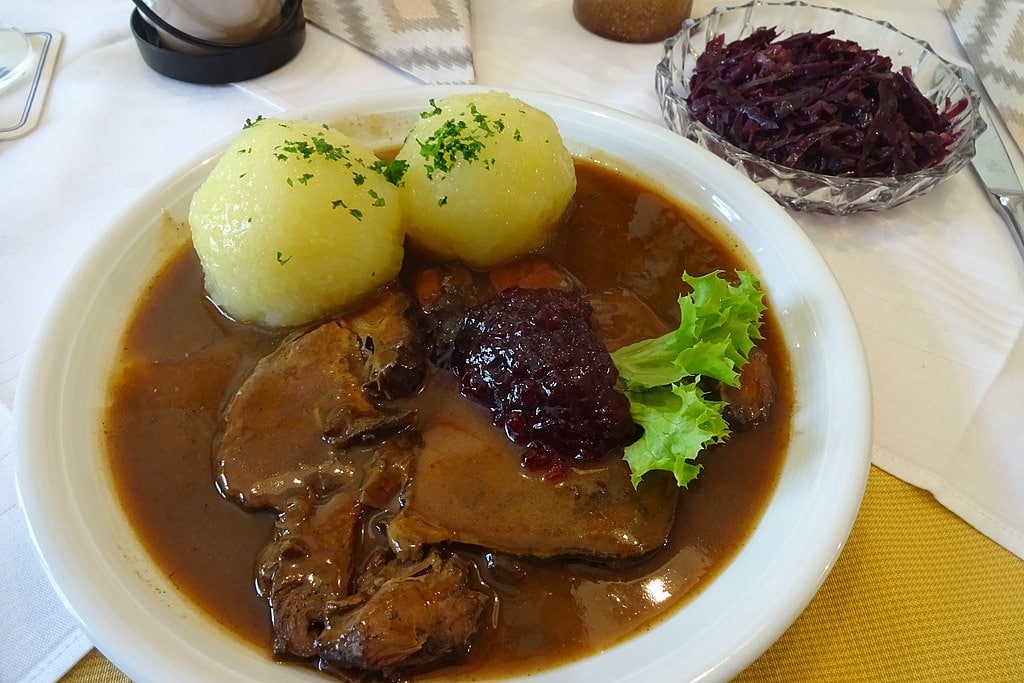
Kartoffelklöße or Kartoffelknödel
Kartoffelklöße or kartoffelknödel are German potato dumplings. They are made with raw potatoes or cooked potatoes (depending on the region) mixed with seasonings and flour.
Schnitzel
The German version is made with tenderized pork or turkey and can be ordered in most traditional German restaurants. It is a very popular meat dish in Berlin. It is made of a thin piece of meat that is coated in breadcrumbs. This coating makes the meat crispy after frying. Commonly it is served with potatoes and vegetables.

Königsberger Klopse – kochklopse
Today, königsberger klopse, named after the old East Prussian city of Königsberg (now Kaliningrad in Russia). may be found in most German restaurants with their traditional name. A German meatball dish served with a traditional cream and caper sauce. The meatballs are traditionally made from veal although this can be substituted. The meatballs are simmered in salted water and when cooked the water is thickened with a roux, cream and egg yolks with capers added. The resulting dish is usually served with beetroot, boiled or mashed potatoes.
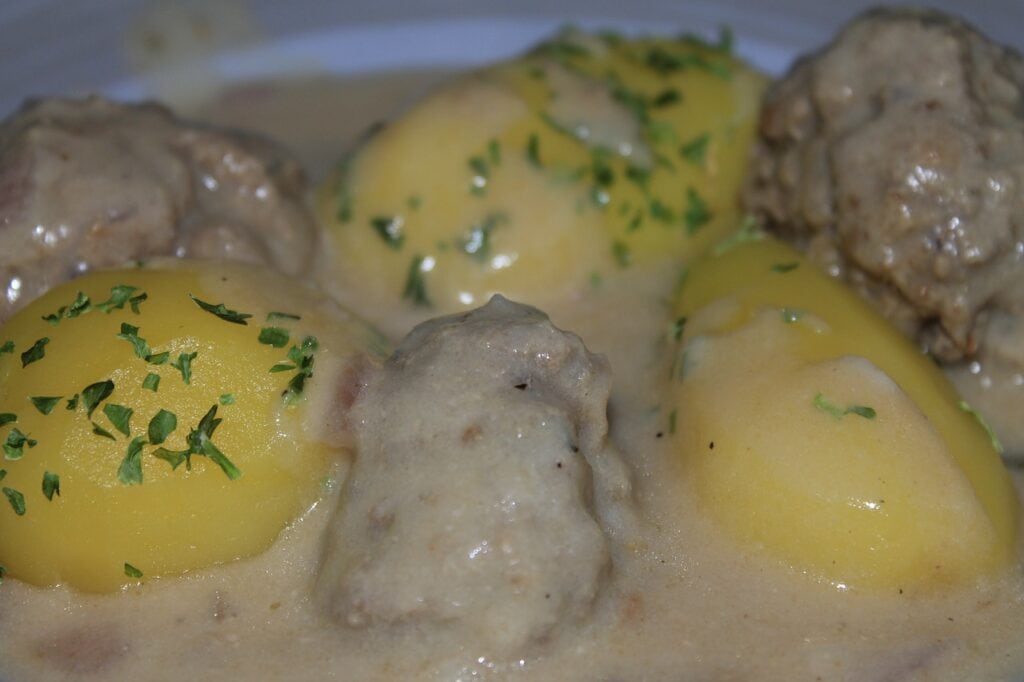
Butterkase – Butter cheese
Butterkäse is a semi-soft, cow’s milk cheese very popular in Germany and Austria for its creamy texture, and buttery taste.
Doner Kebab
One of the most popular German dishes and German street food is a kebab. Many people would love to believe that given Berlin’s Turkish population, the Doner was invented in Berlin. The most popular kebab maker Kadir Nurman – recognised in 2011 by the Association of Turkish Döner Manufacturers is the man most often credited with inventing the Döner Kebab in Berlin.

However truth is that many versions of the kebab are found worldwide. From Greek Gyros to Middle Eastern Shawarma, and tacos al pastor in Mexico, these all fall into the category of ‘kebab’ which is simply put meats cooked on a vertical rotisserie and served in a sandwich form.
Brot & Brötchen
Brot or bread in Germany is usually served with most meals but particularly breakfast and dinner. German bread includes the famous German rye or pumpernickel. German bread tends to be heavier and much heartier than Western white or whole grain bread.
German Pretzels
A very popular German street food an authentic German pretzel made from a dough that is poached in water with sodium bicarbonate very briefly it is removed from the water bath, sprinkled with coarse salt and then baked. Pretzels are addictive and can be made sweet or savoury and are found at dozens of street food stalls across Berlin.
The legends say that a court baker was going to prison after serving the King badly baked bread. His wife begged the king to give him a second chance. The king challenged the baker to produce bread through which the sun would shine 3 times.
The baker was attempting to figure out a recipe when he saw his wife kneeling in prayer with her arms crossed and seeing this he replicated the posture with his dough. It was said that his cat came along and knocked onto the baking sheet some baking soda and the pretzel was born when baked.
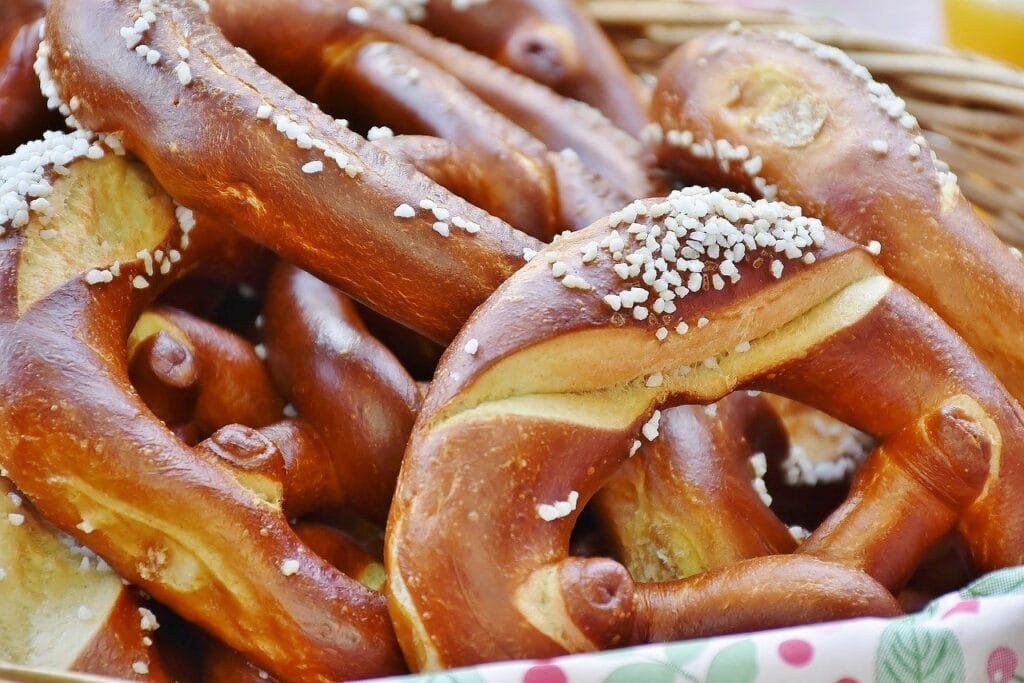
German Foods – Sweets and desserts
The Berliner
The Berliner is a gorgeous fluffy doughnut filled with plum jam or other fruit jam and coated with powdered sugar. In Berlin, it is called marmalade Pfannkuchen.
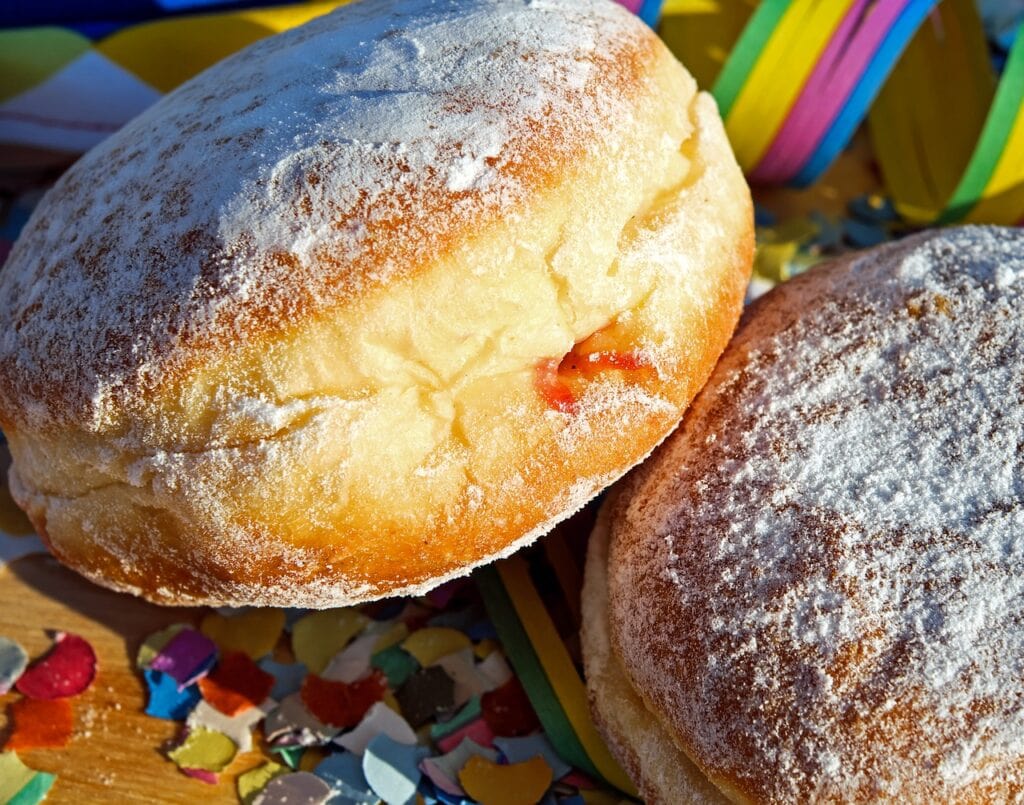
Stollen – Fruit Cake
This German Christmas food is a traditional dish of Fruit Cake containing dried fruit and often marzipan and covered with sugar, powdered sugar or icing sugar.
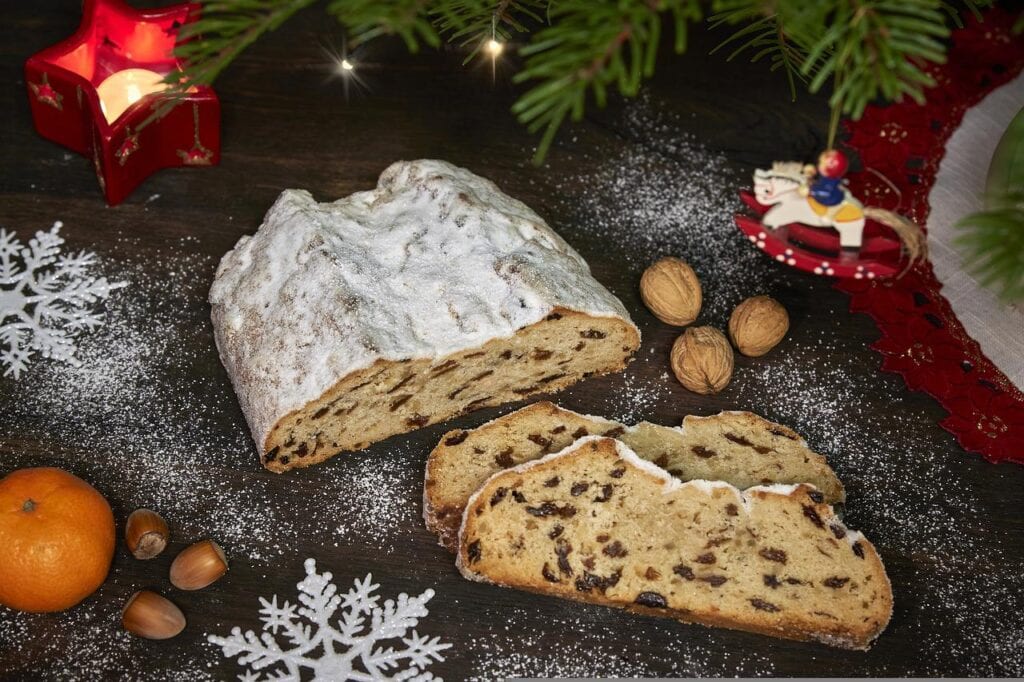
Gebrannte Mandeln (Cinnamon Sugar Almonds)
Found in every German Christmas market these are cinnamon sugar-coated almonds served in paper cones.
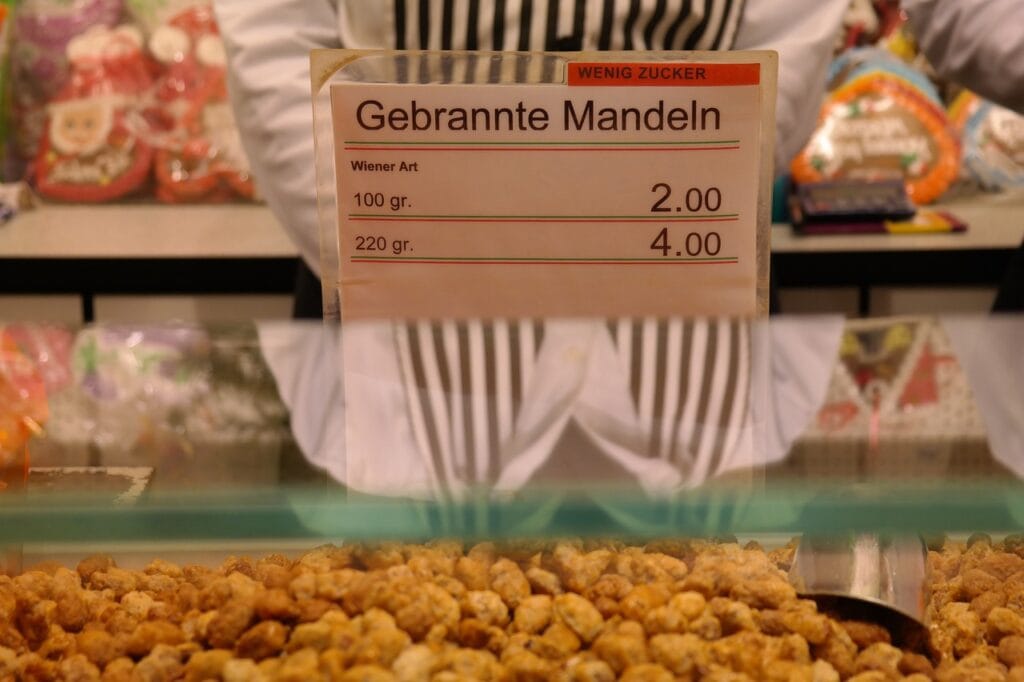
Käsekuchen
Traditional German cuisine usually involves a cheesecake of some description and a versio of cheesecake exists in almost every region of Germany. However these rarely include fruit of any kind and the base is a dough instead of cracker or biscuit crust.
The filling is made with low-fat quark instead of cream cheese and egg foam is added to give it more fluff, plus lemon and vanilla for some extra freshness.
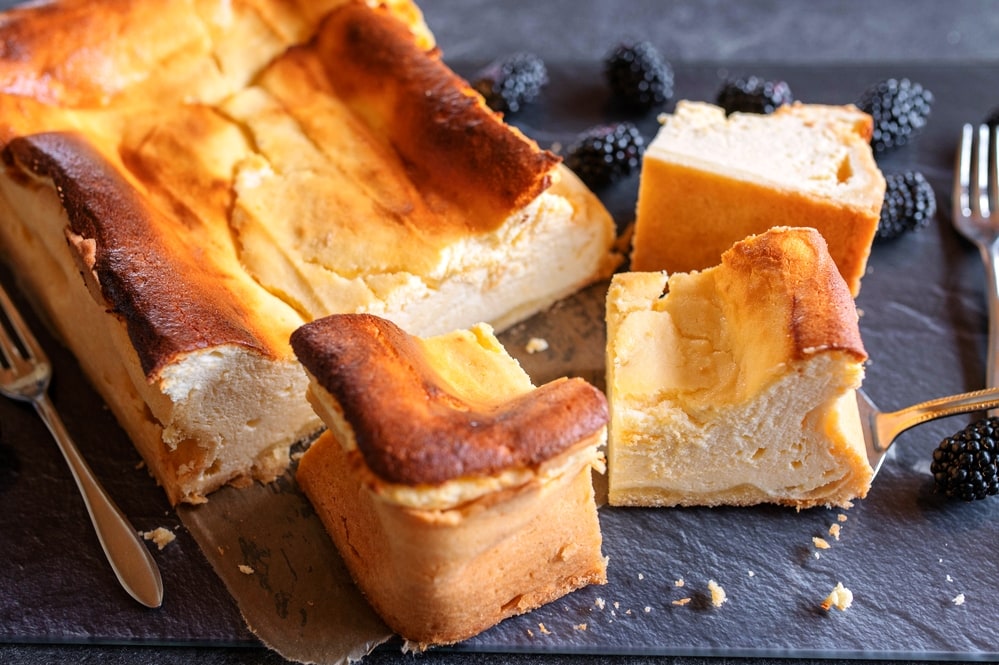
Pflaumenkuchen – Plum cake
German Plum Cake is a coffee cake made with a simple batter crust, fresh plums, and a sweet, crumbly streusel topping
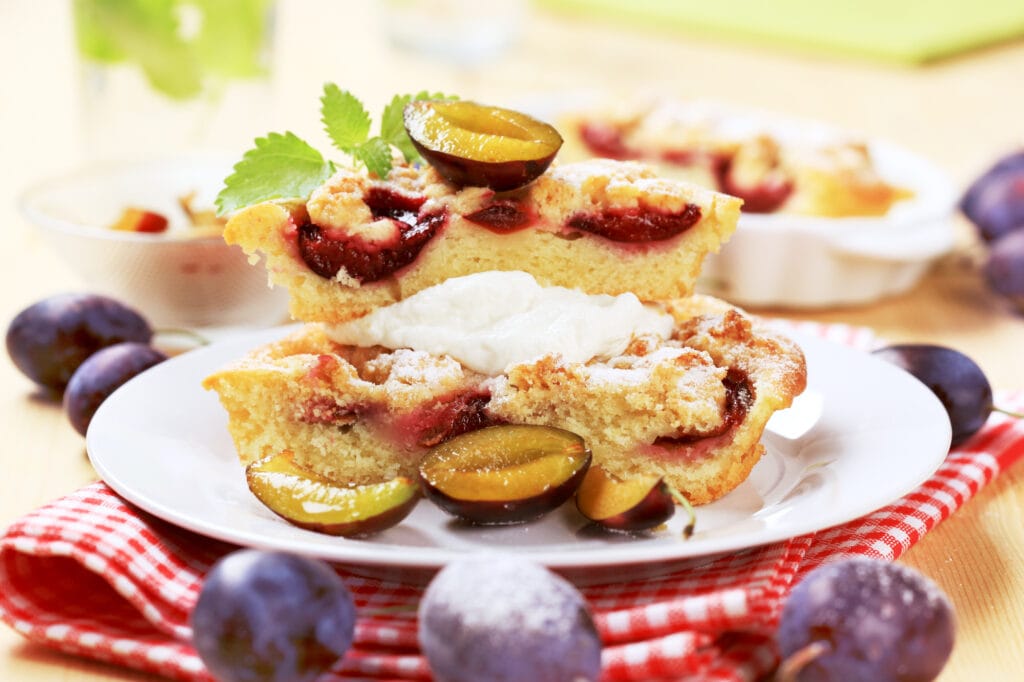
Lebkuchen Cookies
Lebkuchen is called a German gingerbread (even though it’s different from American gingerbread), is enjoyed on a few special occasions during the year and comes in different flavours, sizes, shapes, and textures.
Lebkuchen cookies, for example, are a staple treat in nearly every German home during the Christmas season and can be found decorated with fancy piped icing in every Christmas market.
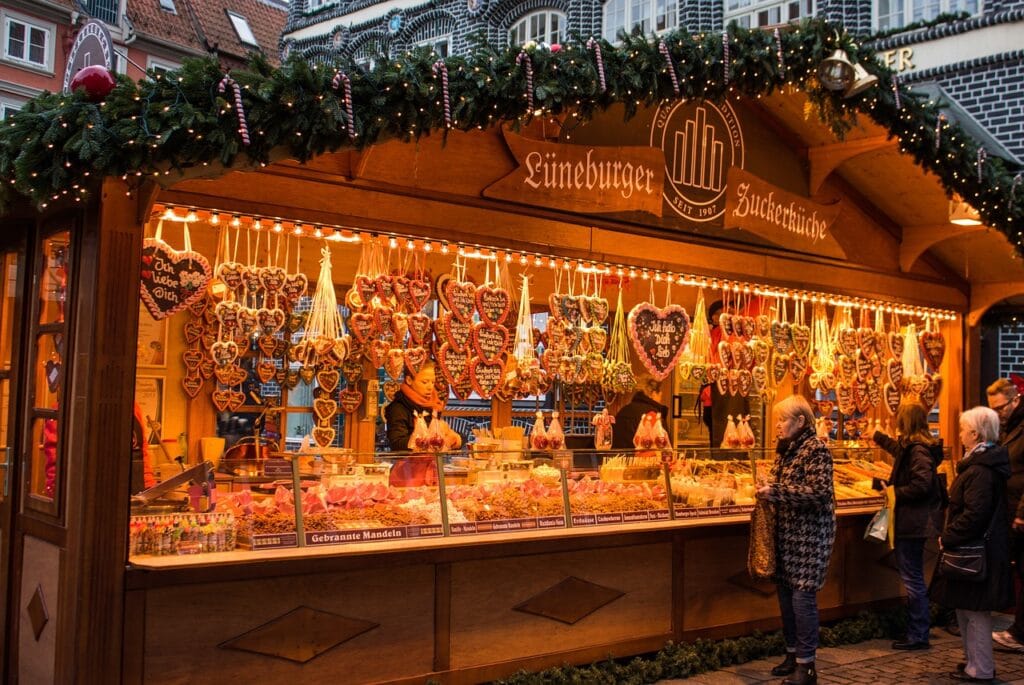
Apfelstrudel
It is a very popular dessert in Berlin eateries. The incredibly thin pastry is filled with chopped apples and sugar. On top, it can be seasoned with cinnamon, breadcrumbs, and sugar powder.
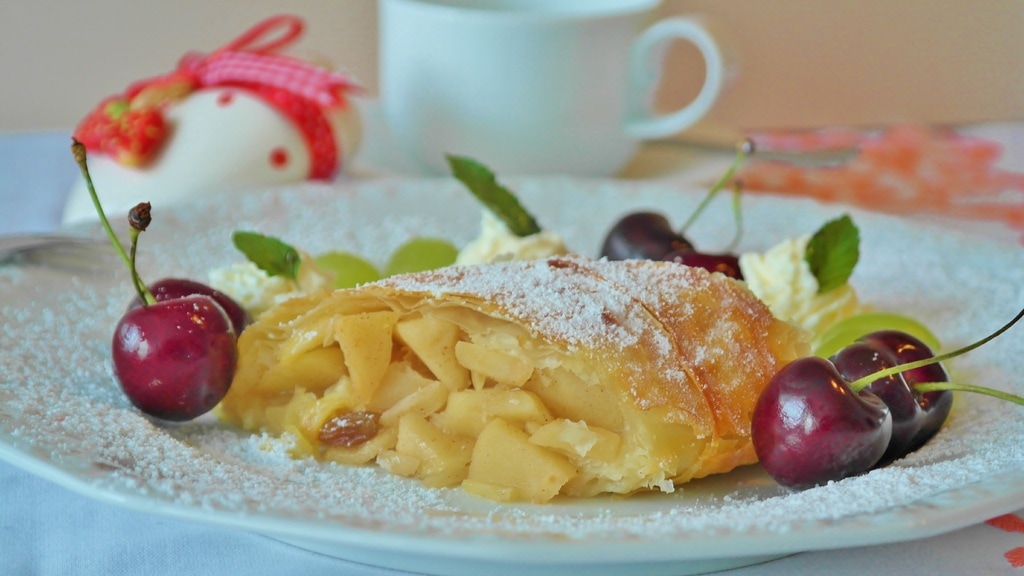
Schwarzwälder Kirschtorte – Black Forest Cake
If you were alive in the 70s and 80’s you must have had Black Forest Cake or as they call it in the UK Black Forest Gateau. This is a layered chocolate sponge filled with cherries, jam, cream and Kirsh a cherry liqueur.
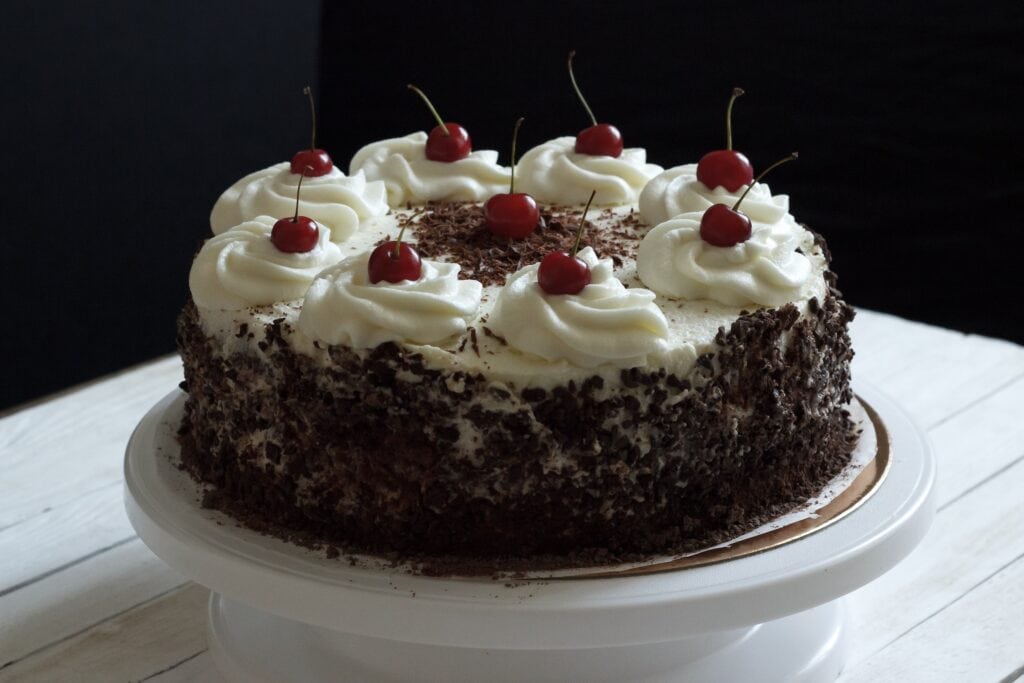
In Germany, drinking alcohol is common among adults. Beer, schnapps, brandy, and German wines such as Riesling are all enjoyed in bars, restaurants, and at home.
And there you have it my guide to all those fabulous traditional German foods you have to try when visiting this amazing country.
More to read
Germany travel guide – 21 places to visit in Germany
Food in Malta – the ultimate guide
French Food Culture: The Ultimate Guide
Best food markets and food halls in N. America
Spanish Food: 40 of the best foods in Spain
59 Traditional British Foods – from the sublime to the WTF
What to eat in Rome the superb food of Italy
148 National Dishes of countries around the world
42 scrumptious heavenly Turkish foods to try
Pin it to save it
